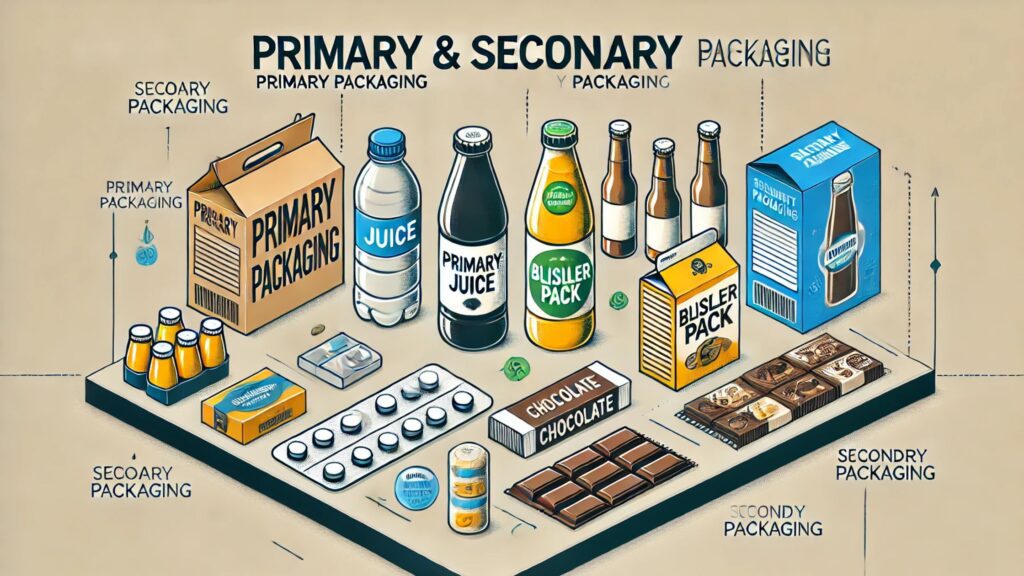Primary and Secondary Packaging: Packaging plays a crucial role in protecting products, enhancing their appeal, and ensuring ease of transportation. It is broadly categorized into primary and secondary packaging, each serving a distinct function. Understanding the differences and purposes of these two packaging types is essential for businesses looking to optimize their packaging strategies.
What is Primary Packaging?
Primary packaging is the first layer of packaging that comes into direct contact with the product. Its primary purpose is to contain, protect, and preserve the product while ensuring convenience for consumers. This type of packaging is often designed to enhance user experience and maintain product integrity.
Examples of Primary Packaging:
- Food and Beverage: Bottles for soft drinks, cans for soup, and wrappers for chocolates.
- Pharmaceuticals: Blister packs for tablets and vials for injectable medicines.
- Cosmetics: Lipstick tubes, foundation bottles, and cream jars.
What is Secondary Packaging?
Secondary packaging is an additional layer that helps in grouping and protecting primary-packaged products. It plays a crucial role in logistics, branding, and ensuring that products reach consumers in an organized manner. Secondary packaging is often designed to be visually appealing and can include marketing elements such as branding, product descriptions, and promotional materials.
Examples of Secondary Packaging:
- Cartons and Boxes: Used for packing multiple units of primary-packaged products, such as a box of cereal or a case of soda cans.
- Shrink Wraps: Commonly used for bundling bottled water or soft drink packs.
- Display Packaging: Designed for retail shelves to present products attractively, such as countertop displays for candy bars.
Key Differences Between Primary and Secondary Packaging
- Function: Primary packaging protects and preserves the product, while secondary packaging facilitates storage, transportation, and branding.
- Material: Primary packaging materials are chosen for safety and direct product interaction (e.g., glass, plastic, foil), whereas secondary packaging materials focus on strength and marketing appeal (e.g., cardboard, paperboard, shrink wrap).
- Consumer Interaction: Consumers directly handle primary packaging, whereas secondary packaging is typically removed before product use.
The Importance of Primary and Secondary Packaging
Both types of packaging are essential for a product’s lifecycle. Primary packaging ensures the product reaches the consumer in optimal condition, while secondary packaging enhances logistical efficiency and brand visibility. Companies must carefully design their packaging to balance functionality, sustainability, and cost-effectiveness.
Sustainable Packaging Trends
With growing environmental concerns, businesses are now focusing on eco-friendly primary and secondary packaging solutions. Biodegradable materials, recyclable packaging, and minimalistic designs are becoming more popular as companies strive to reduce their carbon footprint.
Conclusion
Primary and secondary packaging are indispensable in the modern supply chain. Understanding their roles helps businesses make informed decisions that improve product protection, branding, and sustainability. By optimizing packaging strategies, companies can enhance customer satisfaction while minimizing environmental impact.
Related Articles
- The Art and Science of Packaging | Trends, History & Future
- The Importance of Secondary Packaging Machinery in Modern Manufacturing
- Secondary Packaging in Pharmaceutical Industry: Importance & Innovations
- What Is Secondary Packaging? The Essential Guide for Businesses
- The Ultimate Guide to Popcorn Packaging: Innovation, Trends, and Sustainability
- The Art and Science of Honey Packaging: A Guide to Preserving Nature’s Sweetness
- The Future of Takeaway Packaging: Sustainable and Innovative Solutions
- What Is Primary Packaging? A Complete Guide
- The Future of Manufacturing: Primary Packaging Automation
- Chocolate Primary Packaging: Ensuring Freshness, Safety, and Appeal

